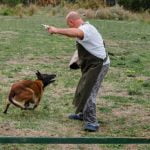Dogs are incredible creatures known for their loyalty and unwavering companionship. However, just like humans, dogs can experience fear and anxiety, which can significantly impact their overall well-being. In this article, we will dive into how to train a dog to be less fearful, understanding the importance of addressing fear in dogs and the negative impact it can have on their quality of life.
Fear in dogs should not be taken lightly, as it can lead to various behavioral issues if left unaddressed. It is crucial to recognize the signs of fear in our furry friends so that we can provide them with the support they need. We will explore common fear signals in dogs, such as trembling, panting, and lowered body posture, along with specific fear triggers and situations.
Creating a safe and comforting environment is key when working with fearful dogs. A secure and peaceful space can help them feel more relaxed and less anxious. We will discuss the significance of setting up a designated “safe zone” at home, providing practical tips on how to create this calming environment for your beloved pet.
Training methods centered around positive reinforcement have proven to be highly effective in reducing fear in dogs. By rewarding desirable behaviors and redirecting or ignoring fear responses, we can help our canine friends overcome their fears more confidently. In addition to positive reinforcement techniques, gradual exposure to triggers is another vital aspect of training fearful dogs. We will explore the concept of systematic desensitization and the importance of introducing feared stimuli in controlled environments.
Ultimately, empowering our dogs to be fear-free requires patience, consistency, and a supportive mindset. As we embark on this journey together, let us celebrate every small victory achieved by our four-legged companions while acknowledging the potential for positive change through training.
Recognizing fear signals in dogs
Some common signs of fear in dogs include trembling, panting, lowered body posture, tucked tail, ears held back or flat against the head, dilated pupils, excessive yawning, lip licking, and cowering. It’s important to note that each dog may exhibit some or all of these signs differently. For example, one dog may freeze when fearful while another may try to escape or hide.
In addition to these general signs, dogs also have specific fear triggers and situations. These can vary widely from one dog to another but often include loud noises such as thunderstorms or fireworks, unfamiliar people or animals, certain objects or situations like vacuum cleaners or car rides, and even specific places like veterinary clinics or grooming salons. By paying attention to what specifically triggers fear in your dog, you can better tailor training techniques to address those particular fears.
| Common Fear Signals | Situational Fear Triggers |
|---|---|
| Trembling | Loud noises (e.g., thunderstorms) |
| Panting | Unfamiliar people or animals |
| Lowered body posture | Certain objects or situations (e.g., vacuum cleaners) |
| Tucked tail | Specific places (e.g., veterinary clinics) |
By recognizing fear signals in dogs, dog owners can take proactive measures to address those fears and create a more comfortable and secure environment for their pets. The next section will discuss how to create a safe and comforting environment for fearful dogs.
Creating a safe and comforting environment
The significance of a secure and peaceful space
For fearful dogs, having access to a safe and comfortable environment is essential for their well-being. When faced with fear triggers or stressful situations, dogs need a place where they can retreat to feel safe and calm. An ideal safe space should be free from loud noises, excessive stimulation, or any potential threats that may exacerbate their fear.
As pet owners, we can create this kind of environment by identifying areas in our homes that are quiet, secluded, and low-stress. It could be a specific room or even just a corner with cozy bedding where the dog can retreat when feeling overwhelmed. It’s important to ensure this designated safe zone is consistently available for the dog so that they know they have somewhere to go when they need it.
Tips for setting up a designated “safe zone”
To set up an effective safe zone for your fearful dog:
- Choose an appropriate location: Select a quiet area away from high-traffic areas in the house. Ideally, it should be in an area where the dog does not feel isolated but can still have some privacy.
- Provide comfortable bedding: Place soft bedding or blankets in the designated safe space to create a cozy environment where the dog can relax.
- Include favorite toys or items: Consider adding familiar toys or items that bring comfort to your dog. These familiar scents can help create an atmosphere of security.
- Optimize lighting conditions: Dogs may feel more comfortable in a dimly lit environment, so use soft lighting or curtains to control the level of brightness in the safe zone.
- Use calming aids: Explore the use of calming aids such as pheromone diffusers or weighted blankets, which can help create a soothing atmosphere in the safe space.
Remember, creating a safe and comforting environment is just one aspect of helping your fearful dog overcome their fears. It’s important to incorporate this step along with positive reinforcement training techniques, gradual exposure to triggers, and counter-conditioning exercises for optimal results. By providing a secure space for your dog and incorporating these strategies into their training routine, you can help empower them to become less fearful and lead a happier life.
Positive reinforcement training techniques
The concept of positive reinforcement training
Positive reinforcement training is based on the belief that rewarding desirable behaviors encourages their repetition, while ignoring or redirecting unwanted behaviors helps extinguish them over time. When it comes to fearful dogs, positive reinforcement techniques focus on rewarding instances where the dog displays courage, calmness, or any behavior that shows progress in overcoming fear.
The key to successful positive reinforcement training is identifying what motivates your dog. This could be treats, praise, toys, or anything else your dog finds reinforcing. By pairing rewards with desired behaviors, you can create positive associations and change how your dog perceives fearful situations.
Steps for implementing positive reinforcement training with a fearful dog
- Identify desirable behaviors: Make a list of specific behaviors you want your dog to exhibit when faced with fear triggers. For example, if your dog trembles during thunderstorms, you may want to reward them for lying down calmly instead.
- Start small: Begin by finding situations or triggers that evoke mild levels of fear in your dog. This could be a mildly anxiety-inducing noise or object. The idea is to gradually increase the difficulty level as your dog becomes more comfortable with each step.
- Timing is key: Immediately reward and praise your dog whenever they display the desired behavior or show signs of being more relaxed than before. Be consistent and ensure that the reward is given within seconds of the behavior occurring to reinforce the association effectively.
- Ignore fear responses: If your dog exhibits signs of fear such as panting or trembling, it’s important not to punish them or give excessive attention that might inadvertently reinforce this response further. Instead, redirect their attention to something positive or engage them in an alternate activity that brings them joy.
- Consistency matters: It is vital to be consistent throughout the training process. Stick to the chosen rewards, keep the criteria for reinforcement clear, and ensure everyone interacting with your dog follows the same approach. This consistency will help your dog understand what behavior is expected of them and create a stronger bond of trust.
Using positive reinforcement techniques for training fearful dogs is a compassionate and effective way to help them overcome their fears. By rewarding desirable behaviors and gradually exposing them to fear triggers in a controlled manner, you can empower your dog to become more confident and less fearful over time.
Gradual exposure to triggers
When it comes to helping fearful dogs overcome their fears, gradual exposure to triggers is a key training technique. This method involves systematically desensitizing dogs to their fears by introducing them to feared stimuli in a controlled and manageable way. By gradually exposing dogs to the things that scare them, they can learn to cope with their fears and build confidence over time.
To start implementing gradual exposure, it’s important to identify specific fear triggers for your dog. These triggers could include thunderstorms, loud noises, strangers, or certain environments. Once you have identified the triggers, create a list in order of least triggering to most triggering.
When starting this process, it’s crucial to keep in mind that each dog is unique and will require different timelines and approaches. Begin with the least triggering item on your list and expose your dog to it briefly and at a distance that doesn’t elicit an intense fear response. For example, if your dog is fearful of strangers, you can start by having a friend stand far away from your dog while engaging in a non-threatening behavior.
During these exposure sessions, make sure your dog feels safe and comfortable. Provide treats or toys as positive reinforcements for calm behavior or moments of bravery. It may also be helpful to distract your dog with play or training exercises during the exposure process.
As your dog becomes more comfortable with each step of exposure, gradually increase the intensity or proximity of the trigger. However, it’s important not to rush this process as it may overwhelm your dog and set back progress. Be patient and always stay within your dog’s comfort zone.
Remember that gradual exposure involves small steps towards overcoming fear, so progress might be slow at times. Celebrate every small victory along the way. Each time your dog displays improved behavior or shows signs of reduced fear around triggers, acknowledge their efforts with praise and rewards.
By consistently working on gradual exposure to triggers, you can empower your dog to face and conquer their fears while building their confidence and trust in you.
Counter-conditioning exercises
One effective counter-conditioning technique is known as “treat and retreat.” This involves exposing the dog to a low-level fear trigger while providing them with treats or rewards. For example, if your dog is afraid of strangers, you can have a trusted friend or family member approach at a distance that doesn’t elicit fear in the dog. As they approach, you give your dog treats and praise, creating positive associations with the presence of strangers.
Another technique is known as “desensitization.” This involves gradually exposing the dog to their fear trigger in a controlled manner. For instance, if your dog is scared of loud noises like thunderstorms, you can start by playing recorded thunder sounds at a very low volume and rewarding your dog for remaining calm. Over time, you can gradually increase the volume until your dog no longer reacts fearfully.
In addition to these exercises, it’s important to be patient and consistent with your training. Remember that progress may be slow and that each dog responds differently. It’s also crucial to create a calm and supportive environment during these exercises, as any sign of stress or impatience from the owner can hinder progress.
Overall, counter-conditioning exercises provide an effective way to help fearful dogs overcome their fears and develop more positive associations. By consistently exposing them to feared stimuli in controlled environments while providing rewards and positive experiences, we can empower our dogs to become less fearful and live happier lives.
| Counter-Conditioning Exercise Techniques |
|---|
| Treat and Retreat |
| Desensitization |
| Patience and Consistency |
Seeking professional help
Professional help can provide a tailored and comprehensive approach to training, taking into account the specific needs and triggers of each individual dog. These experts have experience working with a variety of different fearful behaviors and can offer valuable insights, techniques, and strategies that may not be readily available to the average dog owner.
When seeking professional help for a fearful dog, it is important to choose someone who is experienced and qualified in dealing with fear-related issues. Look for professional certifications or credentials, and ask for recommendations from trusted sources such as veterinarians or other dog owners who have had success in training their own fearful dogs.
Working with a professional can also provide emotional support and reassurance for dog owners. Dealing with a fearful dog can be stressful and overwhelming at times, but having someone knowledgeable by your side can help alleviate some of the anxiety and provide reassurance that you are on the right path towards helping your dog become less fearful.
Patience and consistency
When working with a fearful dog, it is important to remember that progress may be slow. Each dog is unique and will require different amounts of time to feel comfortable in certain situations. Therefore, it is essential for dog owners to remain patient and not rush their pet’s progress. Rushing can cause further anxiety and setbacks in the training process.
Consistency is also key when training a fearful dog. A consistent routine can provide stability and reassurance for dogs that are prone to fearfulness. Maintain a regular schedule for feeding, exercise, playtime, and training sessions. This consistency helps establish trust between you and your dog while creating a structured environment that they can rely on.
Additionally, it’s important to use consistent cues or commands during training sessions. Dogs thrive on clear communication, so be sure to use the same words or gestures each time you want them to perform a specific behavior. Consistency in your actions and expectations will help your dog understand what is expected of them, leading to increased confidence and decreased fear.
While it may be tempting to give up or become frustrated when progress seems slow or non-existent at times, it’s important to remember that patience and consistency are vital components of helping your fearful dog overcome their anxieties. By maintaining a calm and supportive attitude throughout the process, you are creating an environment in which your furry friend feels secure enough to face their fears head-on.
Celebrating small victories
Training a dog to be less fearful is a journey that requires time, patience, and consistency. Along this journey, it is important for dog owners to celebrate the small victories that their canine companions achieve. By acknowledging and celebrating even the smallest progress made by a fearful dog, owners can help boost their confidence and motivation, ultimately empowering them to overcome their fears.
Celebrating small victories can include any positive step forward that the fearful dog takes towards overcoming their fear. It could be as simple as staying calm during a previously fearful trigger or showing curiosity towards something that used to cause them anxiety. For example, if a dog used to cower and hide when meeting new people but now approaches them with caution, it is important for the owner to recognize and appreciate this progress.
By celebrating these small victories, owners can create a positive association in their dog’s mind with situations or stimuli that used to trigger fear. This positive association reinforces the idea that there is nothing to be afraid of and encourages the dog to gradually build confidence in those situations. It is essential for owners to use praise, treats, or any form of reward during these celebrations as it further enhances the positive experience for the dog.
It is also beneficial for owners of fearful dogs to share success stories with others who may be going through similar challenges. Sharing these stories not only provides inspiration and motivation for other dog owners but also allows them to learn from each other’s experiences. Additionally, being part of a supportive community can provide emotional support during what may sometimes feel like a difficult journey.
Conclusion
In conclusion, training a dog to be less fearful is an essential step towards improving their overall quality of life. Addressing fear in dogs not only ensures their safety and well-being but also allows them to live more fulfilling and happy lives.
By recognizing fear signals, creating a safe environment, implementing positive reinforcement techniques, practicing gradual exposure to triggers, engaging in counter-conditioning exercises, seeking professional help when needed, and maintaining patience and consistency throughout the training process, dog owners can empower their furry friends to overcome their fears and become more confident.
It is crucial for dog owners to understand that training a fearful dog takes time and effort. Patience and consistency are key in helping these dogs build trust and confidence. Positive reinforcement techniques, such as rewarding desirable behaviors while ignoring or redirecting fear responses, help reinforce positive associations and encourage desired outcomes.
As you embark on this journey with your fearful dog, it is important to celebrate every small victory along the way. Acknowledge the progress your dog makes no matter how small it may seem. Each step forward is a triumph worth celebrating.
Remember, training a fearful dog requires dedication and commitment. It may be beneficial to seek professional guidance from certified trainers or behaviorists experienced in fear-related issues if you encounter severe cases of fear in your dog. They can provide valuable insights tailored to the specific needs of your furry friend.
By addressing fear in dogs through appropriate training techniques and demonstrating unwavering support, we can empower our beloved companions to live fear-free lives. The potential for positive change through training is immense, ensuring that dogs can experience the world with confidence and happiness. So don’t hesitate-start the journey towards empowering your dog today.
Frequently Asked Questions
Can a fearful dog be trained?
Yes, a fearful dog can absolutely be trained. While fear may present some challenges during the training process, it does not mean that it is impossible to train a fearful dog. With patience, understanding, and positive reinforcement techniques, fearful dogs can learn to overcome their fears and develop new behaviors.
How do you train a dog to overcome fear?
To train a dog to overcome fear, it is important to approach the training process gradually and systematically. Start by identifying the specific triggers that cause fear in your dog and then slowly expose them to these triggers in a controlled environment.
This exposure should be done at a pace that allows the dog to feel comfortable while gradually increasing their tolerance level. Positive reinforcement techniques such as rewards, treats, and praise should be used to encourage calm behavior and build confidence over time.
Can a nervous dog be cured?
While complete “cure” may not always be possible for every nervous dog, significant improvement is achievable with proper training and management. Nervousness in dogs can often stem from past experiences or lack of socialization which can lead to anxiety or fearful behavior.
Through consistent training, desensitization exercises, and counter-conditioning techniques like rewarding calm behavior in anxiety-provoking situations, nervous dogs can learn coping mechanisms and become less anxious over time. Professional help from trainers or veterinarians experienced in dealing with anxiety-related behavior can greatly assist in the journey towards helping nervous dogs become more confident and relaxed in their daily lives.

Welcome to the blog! I am a professional dog trainer and have been working with dogs for many years. In this blog, I will be discussing various topics related to dog training, including tips, tricks, and advice. I hope you find this information helpful and informative. Thanks for reading!





